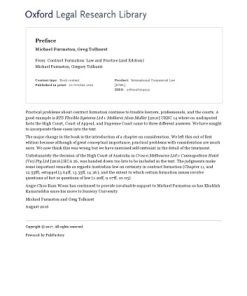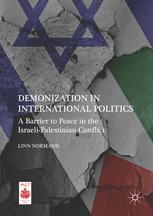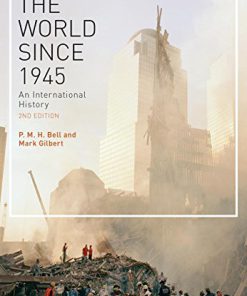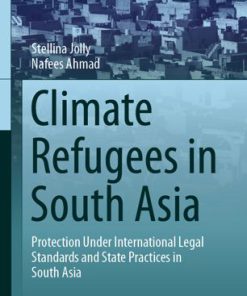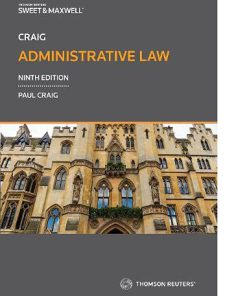Palestinian Refugees in International Law 2nd Edition by Francesca, Lex 0191086797 9780191086793
$50.00 Original price was: $50.00.$25.00Current price is: $25.00.
Palestinian Refugees in International Law 2nd Edition by Francesca Albanese, Lex Takkenberg – Ebook PDF Instant Download/DeliveryISBN: 0191086797, 9780191086793
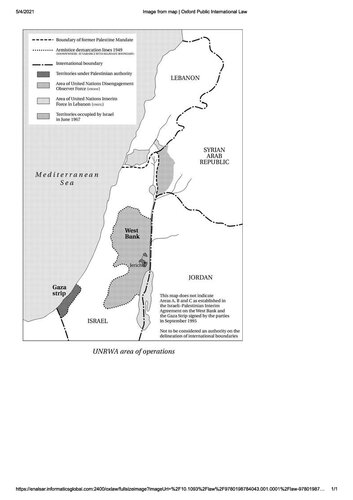
Product details:
- ISBN 10: 0191086797
- ISBN 13: 9780191086793
- Author: Francesca Albanese, Lex Takkenberg
The Palestinian refugee question, resulting from the events surrounding the birth of the state of Israel seventy years ago, remains one of the largest and most protracted refugee crises of the post-WWII era. Numbering over six million in the Middle East alone, Palestinian refugees’ status varies considerably according to the state or territory ‘hosting’ them, the UN agency assisting them and political circumstances surrounding the Israeli-Palestinian conflict these refugees are naturally associated with. Despite being foundational to both the experience of the Palestinian refugees and the resolution of their plight, international law is often side-lined in political discussions concerning their fate. This compelling new book, building on the seminal contribution of the first edition (1998), offers a clear and comprehensive analysis of various areas of international law (including refugee law, human rights law, humanitarian law, the law relating to stateless persons, principles related to internally displaced persons, as well as notions of international criminal law), and probes their relevance to the provision of international protection for Palestinian refugees and their quest for durable solutions.
Table of contents:
1. The Palestinian Refugee Question at a Glance and the Rationale for a New, Expanded Edition
2. Scope and Structure of the New Edition
3. Methodology
3.1 Research methods and sources
3.2 Some remarks on terminology
3.2.1 ‘Asylum seeker’
3.2.2 ‘Diaspora’
3.2.3 ‘Palestine refugees’ vs ‘Palestinian refugees’
4. The Aim of the Study
Part One Historical and Legal Foundations
I. A Historical Overview of the Palestinian Refugee Question
1. Introductory Remarks
2. Prelude to the Palestinian Refugee Question
2.1 Palestine in the cradle of the Ottoman Empire: Days of coexistence
2.2 Palestine in the hands of Britain: Days of destruction, days of revolt
2.3 The last days of the British Mandate: Days of war, days of conquest
3. Palestinian Dispersal and the Early Years of Israel as the ‘Jewish State’
3.1 The refugees from Palestine in figures
3.2 Early years of the State of Israel: Preventing refugee return
4. Early UN Attempts at Resolving the Question of the Palestinian Refugees
4.1 The UN Mediator for Palestine (1948–1949)
4.2 The UNCCP and early negotiations on the refugee issue (1949–1951)
4.3 The Economic Survey Mission and the establishment of UNRWA
4.4 UNCCP efforts related to refugee compensation (1950s–1960s)
4.4.1 The Refugee Office 1952 estimate
4.4.2 The ‘Technical Office’ 1964 estimate
5. Subsequent Displacement of Palestinians
5.1 1967 War and the ‘1967 displaced’
5.2 Further shocks until the present
6. Later Peace Initiatives and Their Relevance for Palestinian Refugees
6.1 The years before the start of the Middle East peace process
6.2 From Madrid to Oslo and Camp David (1991–2000)
6.2.1 Bilateral negotiations
6.2.2 The Quadripartite Committee
6.2.3 The Refugee Working Group
6.2.4 Camp David
6.3 The peace process on life support (2001–present)
7. Concluding Observations
II. Palestinian Refugees: A Distinctive Normative and Institutional Regime
1. Introductory Remarks
2. The Making of the International Refugee Framework
2.1 The interbellum and Second World War refugee arrangements
2.2 The post-war international refugee framework at a glance
2.2.1 The normative framework defining a refugee
2.2.2 The institutional framework to protect refugees
3. Palestinian Refugees in the Making of the New Refugee Regime
3.1 Institutional arrangements: UNCCP and UNRWA, and UNHCR
3.2 Normative setting: Palestinian refugees in the UNHCR Statute and 1951 Convention
3.3 The ad hoc regime seven decades later
4. Defining Palestinian Refugees
4.1 General Resolution 194: Defining Palestinian refugees for the purpose of the (early) search for durable solutions
4.2 The UNRWA definition of a ‘Palestine refugee’: Defining (and registration) for the purpose of delivery of services
4.2.1 A historical account of the development of the UNRWA definition
4.2.2 General considerations with respect to UNRWA registration system and interpretation of the definition of Palestine refugee
Registration system
Interpretation of the UNRWA working definition
4.2.3 The 2009 Consolidated Eligibility and Registration Instructions
‘Palestine refugees’ (1948)
Descendants
Female refugees married to non-refugees (MNR)
Non-(1948) refugees
‘The 1967 displaced’
Other claimants
4.3 Article 1D of the 1951 Refugee Convention: Defining Palestinian refugees for protection outside UNRWA’s area of operations
4.3.1 Earlier debate and interpretations
4.3.2 Recent debate and present interpretation
4.3.3 Personal scope of Article 1D: The subject of the alternative protection regime
4.3.4 Functional scope of Article 1D: The triggers of the alternative protection regime
‘Objective reasons’ as trigger in theory
‘Objective reasons’ as trigger in practice
4.3.5 Applicability of Articles 1C, 1E, or 1F of the 1951 Convention to Palestinian refugees
Article 1C
Article 1E
Article 1F
4.4 Paragraph 7(c) of the UNHCR Statute
5. Concluding Observations
III. On the Application of International Law to Palestinian Refugees
1. Introductory Remarks
2. International Humanitarian Law
2.1 Overview of the Law
2.1.1 International vs non-international armed conflicts
2.1.2 Occupation
2.2 Palestinian refugees and IHL
2.2.1 Historical relevance in 1948
2.2.2 Continuous relevance post-1948
Occupied Palestinian territory (oPt)
Other areas in the Middle East and North Africa region
2.3 Consequences of breaches of IHL under international criminal law
2.3.1 The International Criminal Court
2.3.2 The role of national courts, including through universal jurisdiction
3. The Law Regulating Nationality and Statelessness
3.1 Overview of the Law
3.1.1 The 1954 Convention
3.1.2 The 1961 Convention
3.1.3 Other international instruments
3.2 Relevance of the framework to protect stateless persons for Palestinian refugees
3.2.1 The origins of Palestinian statelessness
3.2.2 The enduring statelessness of Palestinian refugees
4. International Refugee Law
4.1 Overview of the Law
4.2 Palestinian refugees and IRL
5. International Human Rights Law
5.1 Overview of the Law
5.2 Relevance of IHRL for Palestinian refugees
6. The Norms Applicable to Internally Displaced Persons
6.1 Overview of the Law
6.2 Palestinian refugees’ multiple internal displacements
7. Concluding Observations
Part Two Seventy Years of Exile: Palestinian Refugees Around the World
IV. The Status of Palestinian Refugees in the Middle East and North Africa: Unpacking an Unsettling Solidarity
1. Introductory Remarks
2. General Legal Framework
2.1 The role of the Arab League (LAS)
2.2 The Casablanca Protocol and its implementation
2.3 Other regional instruments
3. Palestinian Refugees in UNRWA’s Area of Operations
3.1 The role of UNRWA at a glance
3.2 Jordan
3.2.1 Overview
3.2.2 History
Arrivals over time and numbers
Turning points in history
3.2.3 Legal status and treatment
A case apart: The treatment of Palestinian refugees from Syria
3.3 Lebanon
3.3.1 Overview
3.3.2 History
Arrivals over time and numbers
Turning points in history
3.3.3 Legal status and treatment
Palestinians with permanent residency (holders of Lebanese IDs)
Palestinians without permanent residency and Lebanese IDs
3.4 Syria
3.4.1 Overview
3.4.2 History
Arrivals over time and numbers
Turning points in history
3.4.3 Legal status and treatment
Refugees registered with UNRWA and GAPAR and refugees registered with GAPAR only
Refugees registered with UNRWA but not GAPAR
Non-registered Palestinians living in Syria
3.4.4 The effects of the Syria war on Palestinian refugees
3.5 The Gaza Strip and the West Bank, including East Jerusalem (occupied Palestinian territory)
3.5.1 Overview
3.5.2 History
Arrivals over time and numbers
Turning points in history (the status of the land)
3.5.3 Legal status and treatment
UNRWA-registered refugees (Gaza Strip and West Bank) with Israeli-recognized status
Palestinian refugees with no Israeli-recognized status (Gaza Strip)
Non-registered 1948 refugees (West Bank)
1967 refugees (Gaza Strip and West Bank)
Palestinian refugees with Israeli permanent residency (East Jerusalem)
Palestinian refugees with Gaza identity documents living in the West Bank
UNRWA-registered Palestine refugees from Syria in the Gaza Strip
General treatment of the refugees
4. Arab ‘Hosts’ Outside the UNRWA Area of Operations
4.1 Egypt
4.1.1 Overview
4.1.2 History
Arrivals over time and numbers
4.1.3 Legal status and treatment
4.2 Iraq
4.2.1 Overview
4.2.2 History
Arrivals over time and numbers
Turning points in history
4.3.3 Legal status and treatment
5. Arabian Peninsula
5.1 Overview
5.2 History
5.3 Legal status and treatment
5.3.1 Kuwait
5.3.2 Saudi Arabia
5.3.3 United Arab Emirates
5.3.4 Yemen
6. North Africa/Maghreb
6.1 Overview
6.2 Algeria
6.3 Libya
6.3.1 Overview
6.3.2 History
Arrivals over times and numbers
Turning points in history
6.3.3 Legal status and treatment
6.4 Tunisia
7. Concluding Observations
V. Palestinian ‘Diaspora’ in Europe, the Americas, Asia-Pacific, and Africa
1. Introductory Remarks
2. Europe: Between Openness and Uncertainty
2.1 A glance at history and trends
2.2 Regional legal framework
2.3 Established diaspora
2.3.1 Denmark
2.3.2 France
2.3.3 Germany
2.3.4 Italy
2.3.5 Sweden
2.3.6 United Kingdom
2.4 New destinations and transit routes
2.4.1 Eastern Europe
2.4.2 Northern Europe
Finland
Lithuania
Norway
2.4.3 Southern Europe
Cyprus
Greece
Portugal
Spain
2.4.4 The Western Balkans
2.4.5 Turkey
2.4.6 Other countries in Western Europe
Austria
Belgium
Ireland
Luxembourg
Netherlands
Switzerland
3. The Americas: From the Cradle of Asylum to the ‘Travel Ban’
3.1 A glance at history and trends
3.2 Regional legal framework
3.3 Latin America: Established diaspora, recent trends
3.3.1 Chile
3.3.2 Honduras
3.3.3 Brazil
3.3.4 Argentina
3.3.5 Venezuela
3.4 North America: Historical ports of call
3.4.1 Canada
3.4.2 United States
4. Asia-Pacific: New Frontiers of a Seventy-Year-Long Displacement? (I)
4.1 Overview
4.2 Regional framework
4.3 South East Asia
4.3.1 Indonesia
4.3.2 Malaysia
4.3.3 Thailand
4.4 Other destinations in the region
4.4.1 Australia
4.4.2 New Zealand
4.4.3 Pakistan
4.4.4 South Korea
5. Africa: New Frontiers of a Seventy-Year-Long Displacement? (II)
6. Concluding Observations
Part Three Protection and Solutions
VI. Focusing on Specific Rights
1. Introductory Remarks
2. The Collective Dimension of Palestinian Exile in Legal Terms: The Right to Self-determination
2.1 Origins of the right and relevance
2.2 Codification of self-determination as a universal right: Relevance for Palestinian refugees
2.3 Palestinian self-determination: Between occupation and statehood
3. Return and Compensation: Individual Rights Associated with Historic Claims
3.1 Overview
3.2 Origin of the question of return and compensation of Palestinian refugees
3.2.1 The report of the UN Mediator for Palestine
3.2.2 Resolution 194(III) of 1948
3.3 Status of the right of return and compensation in 1948
3.4 Post-1948: No return, no compensation, further displacement
3.4.1 Political developments: Advancing Palestinian refugees’ rights through the UNCCP
3.4.2 Developments on the ground: From 1967 onwards, including the UN response
3.4.3 Developments in the field of international law
Right to return
Right to restitution and compensation
3.5 Challenges to the enforcement of Palestinian refugees’ rights to return and compensation
4. Individual Rights of Palestinian Refugees Affecting Their Daily Lives
4.1 Education
4.2 Employment
4.3 Health
4.4 Housing
4.5 Freedom of movement
4.6 Non-refoulement
4.7 Unity of the family (family reunification)
4.8 The right to enjoy rights (alias: between secure residency and nationality)
5. Concluding Observations
VII. Protection of Palestinian Refugees
1. Introductory Remarks
2. Contextualizing the (Origins of) Protection of Palestinian Refugees
2.1 Initial protection needs and tools in perspective
2.2 Evolution of the concepts of (international) protection
3. Gradual Evolution of UNRWA’s (and early UNHCR) Protection of Palestinian Refugees
3.1 The 1950s–1980s: Progressive emergence of protection needs of Palestinian refugees
3.1.1 Initial delimitation of UNRWA and UNHCR mandates
3.1.2 UNRWA between assistance and emergencies
3.2 The emergence of a bolder approach to protection of Palestinian refugees: The first intifada turning point
3.2.1 Protection (and safety and security) initiatives, including the Refugee Affairs Officers programme
3.2.2 UNRWA as the ‘UN’s eyes and ears for the application of the Fourth Geneva Convention’
3.2.3 Protection needs of Palestinian refugees outside UNRWA’s areas of operations
3.3 Consolidation of the protection regime for Palestinian refugees in the 2000s
3.3.1 The beginning of the OSO programme
3.3.2 Shift of overall approach
3.3.3 The operationalization of protection in UNRWA: A late bloomer?
3.3.4 Enhanced cooperation between UNRWA and UNHCR
4. Existing Challenges: Space for Opportunities?
4.1 General observations
4.1.1 Within UNRWA’s area of operations
4.1.2 Outside UNRWA’s area of operations
4.1.3 Consultation and coordination for better protection
5. Concluding Observations
VIII. The Quest for Durable Solutions
1. Introductory Remarks
2. Resolving Complex Refugee Situations
2.1 Ending refugee status through ‘durable solutions’
2.2 Solutions to material loss and damage
2.3 Restoring collective identity and dignity
3. The Quest for Solutions for Palestinian Refugees in Perspective
3.1 Attempts at resolving refugee status
3.2 Attempts at addressing material aspects of Palestinian exile
3.3 Attempts to address the question of ‘moral responsibility’
3.4 The refugee question through the eyes of the peacemakers
3.4.1 Palestinians, including the refugees
3.4.2 Israel
3.4.3 Arab States
3.4.4 ‘Western’ countries
4. Towards Just and Durable Solutions for Palestinian Refugees
4.1 Centring solutions around international law
4.2 The Palestinian refugee issue as a ‘UN responsibility’: Reviving multi-lateralism through a comprehensive framework for Palestinian refugees
4.3 Fundamental elements of a comprehensive response framework for Palestinian refugees
4.3.1 Adapting the framework to the specificities of the Palestinian situation
4.3.2 Meaning and implications of addressing root causes
‘The past’: Legal and moral dimension
The present and the ‘broader context’
4.3.3 Offering a combination of durable solutions and reparations
5. Concluding Observations
People also search:
palestinian refugees in israel
palestinian refugees in america
palestinian refugees in us
palestinian refugees in the middle east
which country has the most palestinian refugees
You may also like…
Commercial & Financial Law
Contract Formation: Law and Practice 2nd Edition Michael P. Furmston
Jurisprudence & Law - Intellectual Property
Intellectual Property Law: P. Narayanan Parameswaran Narayanan
Politics & Philosophy - Government & Politics
Politics & Philosophy
The World Since 1945 An International History 2nd Edition P. M. H. Bell
Politics & Philosophy
Jurisprudence & Law - Constitutional Law
Arts - Fashion
Historical Dictionary of the Fashion Industry 2nd Edition Francesca Sterlacci Joanne Arbuckle




